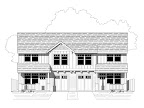Tuesday, December 8, 2015
Efficiency by Design - Foundation
The foundation of your house is perhaps the most important feature. Get it right and the whole house can last for a hundred years or more. Get it wrong and you'll be plagued with callbacks.
We at Istockhouseplans understand this concern. However we also like to weigh the other side of the balance with efficiency by design and optimizing your materials. We did the research and found out how to keep your house strong and save money at the same time.
Years ago we all got used to the idea of building a 12" wide by 6" thick concrete footing for a one story home, a 16"x8" footing for a two story home, and an 18"x10" footing for a three story home. This may not have been code but it was a good rule of thumb with a safety factor. The truth is that two story homes can use 7" thick footings and the 8" thick footing is fine for three story homes or portions thereof. The minimum widths are pretty close with 12"/15"/18" being required for one, two, and three stories. Perhaps we just liked rounding up to 2" increments. This all assumes a stick framed house on soil with a load bearing capacity of 1500 lbs or more.
But even this is a prescriptive approach. If you can show by calculations that a narrower wall can support the load (such as a gable end wall where the joists and trusses run parallel) then more concrete can be saved.
The biggest savings can be realized in the wall itself. The width of the concrete wall is often increased as the number of stories increase. But the code now allows for a concrete foundation wall thickness equal to the wall above with a minimum of 6". This means that even for a three story home built with 2x6 framing, the concrete stem wall need only be 6" thick. This means a savings of almost two yards of concrete on a single 40'x40' home.
Interior footings should also be considered. It is common for point loads to exert a force larger than the normal layout can handle. There are a couple of ways to handle this. One is to calc the footing size needed, understanding that the concrete contractor will generally overpour it. On interior foundation walls it should be preferred to specify a round footing. These are easier to form than a square for isolated footings.
Along the exterior however, square flared footings are more in keeping with how the foundation is built. It is common to make the footings square, even if it is 20" in a 15" footing. There's only an extra 2-1/2" inches of concrete on each side. A more advanced procedure would be to assume a rectangular flared footing that is no wider than the footing. If you can prove that a 15"x27" section of the concrete footing can handle the point load and tributary loads, no flared footing is needed.
These techniques are not difficult. We have spent years testing and honing them to find out what works and doesn't. Simply begin the conversation with an email or phone call. We'll handle the rest.
Subscribe to:
Post Comments (Atom)







No comments:
Post a Comment